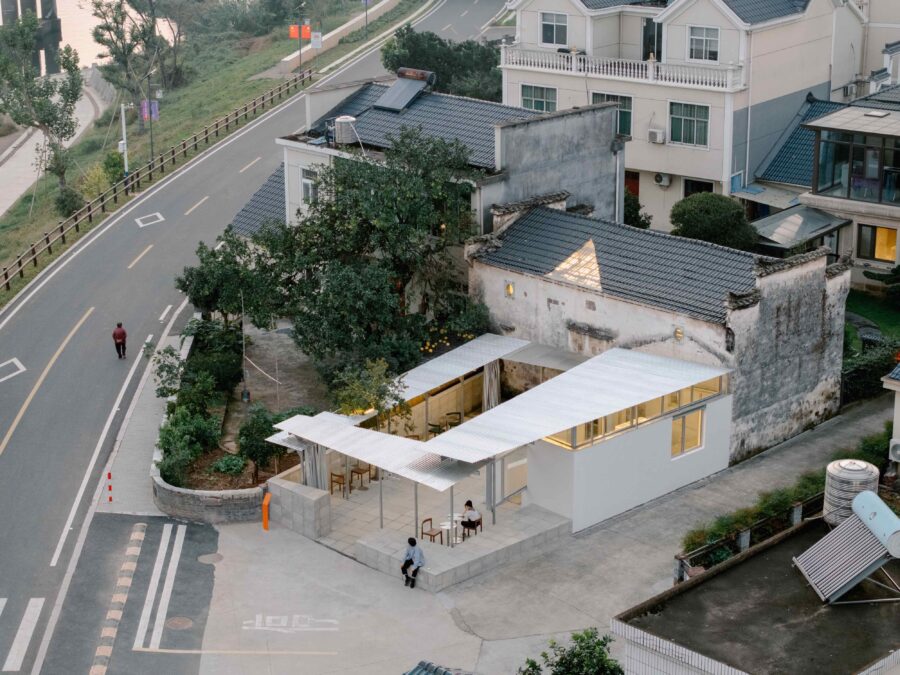
CULTURE


©︎ NEXT architects
〈オランダ・大方・クリエイティブビレッジ(Holland Dafang Creative Village)〉は、数百年の歴史を持つ中国の村に新しい命を吹き込むプロジェクトです。過疎化した農村を救うため、中国でさまざまな取り組みが進む「農村活性化プロジェクト」として、中国とオランダの文化と創造性を織り交ぜ、新旧一体となったユニークな環境をつくり出しています。
オランダと中国を拠点に活動する建築事務所NEXTアーキテクツ(NEXT architects)が設計しました。
(以下、NEXT architectsから提供されたプレスキットのテキストの抄訳)

©︎ NEXT architects
中国で進む都市化と過疎化
農村部中心の社会から、2050年には10億人の中国人が都市に住むという推定がされているほど、中国は急速な勢いで都市化が進んでいる。
このような変化と都市への移住の結果、何十万もの村が放棄されている。

©︎ NEXT architects
放棄された農村の多くは、数十年にわたる社会的・文化的遺産を持っているにもかかわらず、その豊かな歴史を未来に紡げるかは不確かな現状となっている。この課題に取り組むため、江西省金渓県の行政より、これら102の廃村の1つ「大方(Dafang)」に対する戦略策定を依頼された。
IVEM(オランダ遺産マーケティング研究所)、Smartland Architects(ランドスケープデザイン)、Total Design(グラフィックデザイン)や数名のアーティストと協力し、NEXTアーキテクツは、マスタープラン、建築、インテリアを担当した。

©︎ NEXT architects
NEXTアーキテクツ北京のパートナーであるジョン・ヴァン・デ・ウォーター(John van de Water)は次のように語る。
「農村の活性化は、これからの中国の発展にとって重要な役割を果たすだろう。そのためには、古いものと新しいもの、住むものと訪れるもの、歴史と未来のバランスをデザインすることが必要だと考えている。」

©︎ NEXT architects
「新しさ」の再認識
大方には900年以上の歴史があり、明朝や清朝時代の遺物がわずかに残っているが、この村は何十年も衰退の一途をたどってきた。
「大方に新しい息吹を吹き込みたい」という金渓行政の願いは、新しいものと古いもの、歴史と未来の対話を明確に求めるデザイン戦略へと結実した。

©︎ NEXT architects
NEXTアーキテクツは、中国とオランダのアーティストたちが現地で制作、交流、展示を行えるよう、魅力的でフレキシブルな環境をデザインした。
建築や ランドスケープを含む村全体が、常に動き続けるインタラクティブな環境となり、新しい世代の訪問者や住民を惹きつけ、インスピレーションを与えることができるのである。

©︎ NEXT architects
新旧一体となったデザイン的介入
大方へのデザインによる介入は、3段階で構成されている。
まず、都市空間、建築、ランドスケープは、可能な限り新しい材料で修復した。これにより、古いものと新しいものの間に対話が生まれている。
例えば、古い家屋の屋根にはガラス瓦が使われ、古い灌漑システムには天然のヘロファイト・フィルター(helophyte filter:葦などを活用した濾過システム)といった新たな要素を加えて修復されている。

©︎ NEXT architects
歴史を受け継ぐ新たな建築
さらに、大方の歴史に由来する新しい展望台と市民ホールも建設された。
この地域の古い村には、防衛のための監視塔である「大方楼」がよく見られた。大方楼はすでになくなっているが、その代わりに、2本の小道が織り込まれた新たな展望台を設置した。
この2本の道は、中国に多く存在する巨大な龍柱を連想させる。展望台からは、豊かな風景と地平線の山々を背景に、村の新旧一体の景色を眺めることができる。この展望台は、中国の有名な詩人である李白が、愛する人の帰りを待つ人々を詠んだ詩にちなみ、「放浪塔」とも呼ばれている。

Tower diagram

©︎ NEXT architects
新たな市民ホールは、中国にて1966年から1976年まで続いた文化大革命で破壊された中庭型の建物の跡地である、村の中心部に建てられた。
このホールのユニークな屋根は、村のすぐ外に古くからあるクスノキの木からインスピレーションを受けて作成された。
何十年もの間、この木の高い樹冠は村人たちの集いの場を形成してした。新たなクスノキのホールも、日陰の集会所として村に溶け込んでいる。テラコッタタイルのファサードは、鳥の巣づくりの場にもなっている。

Champhor concept

©︎ NEXT architects
創造性を喚起する新たな要素
3つ目は、アートとアクティビティに特化した空間づくりである。新たなミュージアム、図書館、アーティストスタジオなど、村に新しい生命と創造性をもたらす機能を追加した。

©︎ NEXT architects
アーティストたちは、村の構造に反応し、要素を追加、変更、変形するよう招かれている。例えば、市民ホールの床は中国人アーティストによりモンドリアン風のパターンで描かれ、オランダ人アーティストのヘルマン・ラマース(Herman Lamers)は、「The Dream」という作品で、古い民家に飛行機を設置した。
〈オランダ・大方・クリエイティブビレッジ〉は、中国とオランダの建築家、デザイナー、アーティストが領域を横断して協力し、田舎の廃村に新しい命を吹き込んだ好例と言えるだろう。

©︎ NEXT architects
NEXTアーキテクツ北京のパートナーであるジャン・シャオフェイ(Jiang Xiaofei)は次のように語る。
「〈オランダ・大方・クリエイティブビレッジ〉にはオープン以来、数多くの訪問者が訪れている。私たちは、この村が社会的、文化的にポジティブで持続的な影響を与え、中国の廃村における新たな発展モデルとなることを期待している。」

©︎ NEXT architects

©︎ NEXT architects

©︎ NEXT architects
以下、NEXT architectsのリリース(英文)です。
Dafang Creative Village
overview
type / program: rural regeneration
location: Dafang, Jiangxi Province / CN
client: Jinxi government
size: 48,000 m²
status: realized
preliminary design: 2018
completion: 2020
design: NEXT architects
TEAM: John van de Water, Jiang Xiaofei with Gao Shuang, Kuang Wenhui, Shen Xue, Liu Wenya, Sun Yi, Lu Xiaorui, Zhu Juncheng, Zhang Chi, Ren Wanting and Yue Haiting
in collaboration with: IVEM (Dutch Institute for Heritage and Marketing), Smartland architects, Total Design and Linda VlassenroodPROJECT TEXT
Holland Dafang Creative Village brings new life to Chinese rural area:
NEXT architects combines Chinese and Dutch cultures and creativity to create unique art villageChina has undergone an unprecedented urbanisation process, from being a predominant rural society to having an estimated one billion Chinese living in cities in 2050. In this transformation so far, urban migration has left hundreds of thousands of villages abandoned. Many of these have dozens of generations of social, cultural and monumental value but are currently lacking major future significance.
To address this challenge, NEXT architects, together with IVEM (Dutch Institute for heritage and marketing), Smartland (landscape design), Total Design (graphic design) and numerous artists were asked by the Government of Jinxi, Jiangxi Province to develop a strategy for one of its 102 abandoned villages, Dafang. NEXT architects was responsible for the masterplan, architecture and interior.
“Rural revitalization is one of China’s key future developments. We believe this asks for the design of balance between old and new, living and visiting, history and future.”
– John van de Water, partner NEXT architects BeijingADAPTING ‘NEWNESS’
Dafang has over 900 years of history but with only a few Ming and Qing Dynasty artefacts remaining, it had been dilapidated for over ten years. The Jinxi governments’ ‘wish for Dutchness to revitalise Dafang’ was translated into the design strategy: ‘adapt to newness’. NEXT architects designed a flexible and attractive environment for Chinese and Dutch artists to work, interact and exhibit locally. The whole village, including its architecture and landscape, becomes an interactive environment constantly able to re-invent itself. As a result, a new generation of visitors and inhabitants will be attracted and inspired.INTERVENTIONS
Interventions are designed on three levels. Firstly, urban space, architecture and landscape are restored where possible, with new materials, creating a dialogue between old and new elements. For example: glass roof tiles are used to restore the roofs of the old houses and the ancient irrigation system has been restored adding elements such as a natural helophyte filter to clean the water.Secondly, a watchtower and public hall have been added: new building structures that take cues from on-site precedents. Ancient villages in this area all had watchtowers for defense purposes. With the original tower long gone, a new watchtower has been designed in which two intertwining routes embrace each-other, loosely resembling a giant Chinese ‘dragon column’. The watchtower provides alternating views over old and new in the village, as well as views as far as over the rural landscape towards the mountains at the horizon. Locally, the watchtower is embraced as the ‘Wandering Tower’, reminiscing a poem of the famous Chinese poet Li Bai about people waiting for loved ones to return to their hometowns.
In the center of the village, a new public hall is realized. The hall is built on the former site of a courtyard building that was destroyed during the cultural revolution. The inspiration and shape for the unique roof comes from a century-old camphor tree outside the village, whose lofty canopy for decades provided a gathering space for the villagers. The camphor hall dissolves in the fabric of the village and provides a shaded collective space. The terracotta tiled facade provides places for birds to build nests.Thirdly, there is the programming of the spaces through art and activity. A new village museum, a library and artist studios are amongst the new functions that bring new life and creativity to the village. Artist are allowed to react on the village structures: to add, change, and transform its context. The floor of the public hall has for example been painted in a Mondrian-like pattern by a Chinese artist. Dutch artist Herman Lamers has installed an airplane in an old house, called ‘The Dream’.
As a whole, Holland-Dafang Creative Village is an inspiring example of a multidisciplinary collaboration of Chinese and Dutch architects, designers and artists to bring new life to rural areas:
“Holland-Dafang Village opened last month, attracting already thousands of visitors each day. We hope it will have a – positive lasting – social and cultural impact and will provide a new development model for abandoned Chinese villages,” says Jiang Xiaofei, partner NEXT architects Beijing.
「Holland Dafang Creative Village」NEXT architects 公式サイト
https://www.nextarchitects.com/holland-dafang-creative-village-2/









